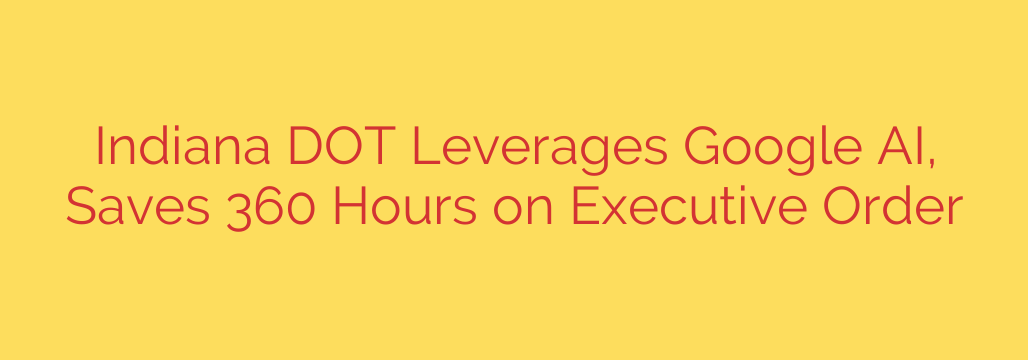
How Indiana’s DOT Saved 360 Hours of Work With a Single AI Tool
In government agencies and large organizations, a new federal mandate or executive order often triggers a massive, time-consuming review process. Teams of experts must manually comb through hundreds of pages of dense, technical language to understand the impacts, identify new requirements, and plan for compliance. This painstaking work can take weeks and pull valuable talent away from other critical projects.
However, the Indiana Department of Transportation (INDOT) recently demonstrated a powerful new approach. Faced with a complex, 150-page White House executive order on artificial intelligence, the agency used a generative AI tool to slash its analysis time from weeks to mere minutes, saving an estimated 360 hours of expert-level work.
This case study offers a compelling look at how AI is moving from a futuristic concept to a practical tool for improving government efficiency today.
The Challenge: A Mountain of Complex Information
When the extensive federal executive order on AI was released, INDOT knew it had a significant task ahead. Like any state agency, it needed to quickly and accurately determine how the new directives would affect its operations, data management, and future technology strategies.
Traditionally, this would involve multiple subject matter experts dedicating days or even weeks to:
- Reading the entire 150-page document from start to finish.
- Identifying all sections relevant to transportation and state governance.
- Summarizing key mandates and deadlines.
- Cross-referencing information to understand the full scope of requirements.
This manual process is not only slow but also carries the risk of human error, where crucial details might be overlooked in the sea of information.
The Solution: AI-Powered Document Analysis
Instead of embarking on this lengthy manual review, INDOT turned to a modern solution: Google’s Vertex AI Search. This platform allows organizations to securely upload their own documents—such as PDFs, legal texts, and policy papers—and then use a conversational interface to ask specific questions about the content.
The process was remarkably simple. INDOT uploaded the 150-page executive order into the system. Within minutes, the AI had processed and “understood” the entire document. Agency staff could then ask direct questions in natural language, such as:
- “What are the compliance requirements for state transportation agencies?”
- “Summarize the key deadlines mentioned in this order.”
- “Does this document impact our data privacy policies?”
The AI responded instantly with clear, concise summaries. Crucially, it didn’t just provide an answer; it cited the exact page numbers and passages from the original document, allowing staff to immediately verify the information and dig deeper where needed.
The Results: Massive Gains in Efficiency and Accuracy
The impact was immediate and profound. A task that would have consumed 360 hours of collaborative work across multiple departments was completed in a fraction of the time. This massive time savings allowed INDOT’s experts to bypass the tedious manual reading and move directly to strategic planning and implementation.
The key benefits extended beyond just speed:
- Enhanced Accuracy: The AI tool ensured that no relevant section was missed, providing a comprehensive overview of the order’s impact.
- Rapid Accessibility: Any team member could quickly query the document and get reliable answers without needing to become an expert on the entire text.
- Verifiable Information: By providing direct citations, the AI tool built trust and enabled a seamless transition from high-level summary to detailed analysis.
This successful implementation showcases a powerful blueprint for how public sector agencies can leverage generative AI to navigate complex regulatory landscapes.
Key Lessons for Modern Organizations
The Indiana DOT’s experience offers valuable insights for any organization, public or private, looking to improve efficiency and make better use of its expert talent.
- Start with a Specific Problem: Instead of a vague “AI strategy,” focus on a clear, high-impact pain point. Document analysis, legal review, and compliance checks are perfect starting points.
- Prioritize Tools That Augment Humans, Not Replace Them: The goal of this project wasn’t to eliminate jobs but to free up skilled professionals from low-value, repetitive tasks. This allowed them to focus on the strategic work that truly requires human expertise.
- Insist on Verifiability: When dealing with important documents like legal orders or compliance mandates, trust is paramount. Choose AI tools that provide clear sources and citations for their answers, ensuring every claim can be easily fact-checked against the original document.
By embracing practical AI solutions, organizations can transform overwhelming data challenges into manageable, actionable intelligence, paving the way for a more efficient and responsive future.
Source: https://cloud.google.com/blog/topics/public-sector/indiana-dot-saved-360-hours-of-manual-effort-to-meet-a-30-day-executive-order-with-google-ai/








